Green Sunfish (Lepomis cyanellus), are small freshwater panfish found throughout much of North America.
They are found in a variety of habitats and are one of the most widely distributed and common of all sunfish species.
They are known for their small, yet aggressive stature and predatory nature.
Table of Contents
About Green Sunfish
The Green Sunfish has a thick body and large mouth, more closely related to bass than to other species of sunfish.
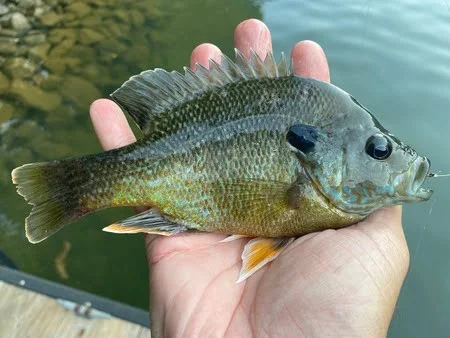
As their name suggests they are blueish-green in color and they have 3 distinct dark spots that help to easily identify them in the wild.
They are very popular among anglers and often caught alongside other species of panfish such as Bluegill and Redear Sunfish.
Description
The Green Sunfish has a larger mouth than many of its sunfish cousins; this is one of the key identifying factors when trying to distinguish the species. They also have a small compressed gill plate, with a dark black opercular ear flap and white or lightly colored edge.
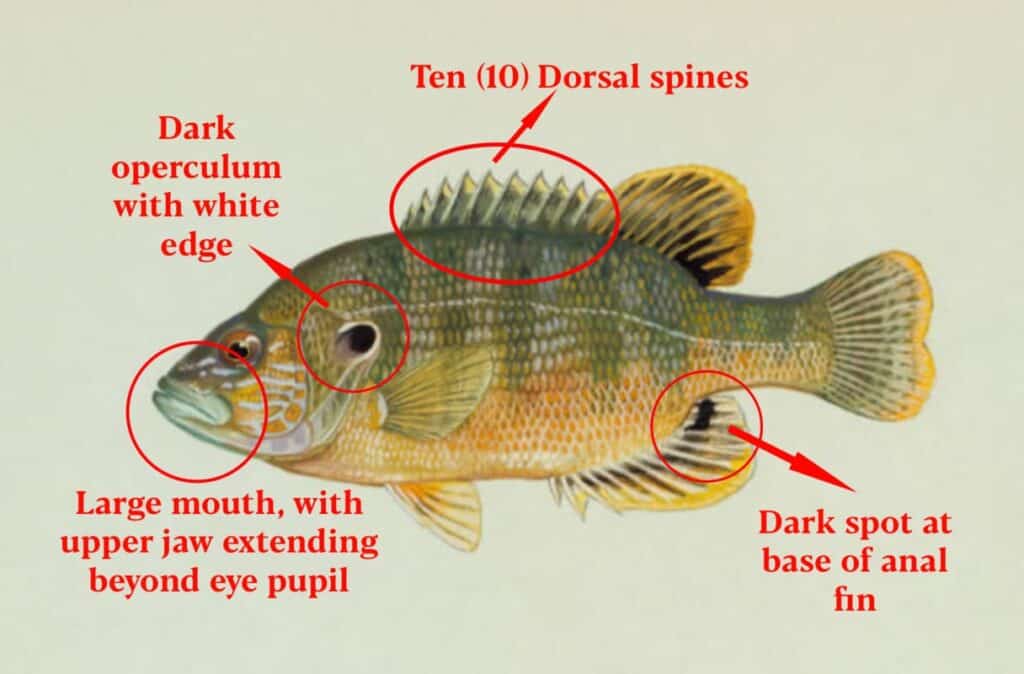
The body shape is thick and semi-elongated; closer to a warmouth body shape than a traditional round panfish shape.
Coloration is usually olive green on the back or upper portion and gradually lighter toward the belly with tones of yellow and brown.
Along the face and gills may be vivid streaked colors of turquoise, green and yellow.
Size
Considered a small panfish, the typical size of the Green Sunfish ranges between 3-7 inches and less than one pound.
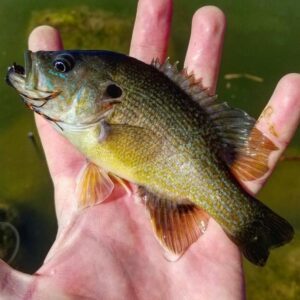
Individuals may reach up to 12 inches in length and nearly two pounds.
Native Range
Green Sunfish are native to much of the southern, midwestern, and northern United States, as well as portions of Canada and northern Mexico.
Accidental and intentional populations have been introduced in nearly every other US state, as well as regions in Europe, Asia, and Africa.
The Green Sunfish is a well-adapted, hardy sunfish capable of strong reproduction rates and is sometimes considered a liability due to their propensity to overpopulate and compete with other desirable game fish species.

Diet
Green sunfish are omnivores, which means they consume both plant and animal matter. They readily eat insects, larvae, zooplankton, eggs, snails, crawfish, and other small forage fish.
Habitat
Green Sunfish prefer slow-moving, lakes, ponds, and creeks with ample cover.
They are often found in the backwaters of sloughs, swamps, and drainages or along vegetated shorelines of lakes.
To find Green Sunfish, look for weedy cover, docks, stumps, rocks, or other structures- chances are they will be nearby!
Spawning
Green Sunfish spawning begins when water temperatures reach 70 degrees Fahrenheit, typically starting mid to late May. Spawning peaks in June and may continue into the month of August.
See Also: How To Find Bluegill Beds & Time The Spawn
Females prefer a rocky or gravel bottom to fan away silt and make a nest. Males will defend nests once eggs are deposited.
Green sunfish will often nest in ‘colonies’, with many nests located in shallow water.
Eggs only take 1-3 days to hatch. Green sunfish are prolific spawners, capable of spawning every 8-10 days through the summer spawning season.
For this reason, Green Sunfish often get ‘stunted‘ due to overpopulation, and they are notorious for overtaking small ponds or streams.
How Do You Catch A Green Sunfish?
Green Sunfish can be caught using the same rigs and methods used when attempting to target other sunfish species.
Try using a small, #6-#10 long shank wire hook under a cork or small bobber.
Popular baits include crickets, worms, nightcrawlers, corn, bread balls, and small minnows.
Often times you can locate Green Sunfish by doing a little scouting. Walk the weedy edges of lakes or ponds, looking for 5-7 inch-sized fish.
Throw in some bread or crushed crackers to get them stirred up and active. Docks, fallen trees, stumps, and rocky gravel creeks are other good places to look.
To catch Green Sunfish on artificial lures, try using your favorite panfish rod and reel and tie on a flashy slow-moving lure.
Johnson Beetle spin, Rebel CrickHopper, 1/16th ounce jig head, or even a dry fly should all produce results. My personal favorite is the Crappie Magnent!
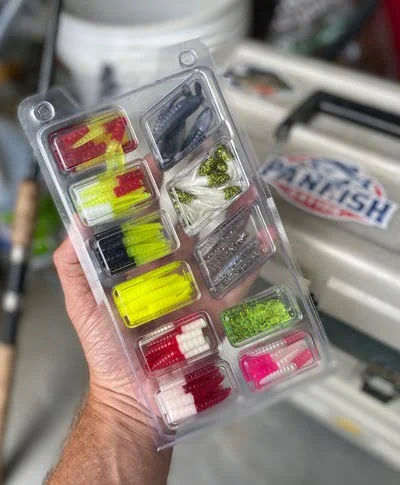
Green Sunfish are not a particularly difficult species to catch. The most important thing is to be sure you are on a body of water that contains Green Sunfish.
Otherwise, these small and feisty panfish are usually plentiful and easy to catch year-round with a little bit of work.
Frequently Asked Questions
Are Green Sunfish Good to Eat?
Yes, Green Sunfish are good to eat. Although they are small in size and not often targeted by anglers for food, the meat is white, flaky, and mild flavored.
Any panfish recipe can be used when preparing Green Sunfish.
Are Green Sunfish Invasive?
Green Sunfish are native to North America, but in certain states and provinces, they are considered invasive.
Due to their prolific spawning habits and adaptability, they are considered a nuisance by some fisheries managers and biologists.
For more information on the status of Green Sunfish and where they are considered invasive, visit the Nonindigenous Aquatic Species information resource center.
Are Green Sunfish Good for Ponds?
No, Green Sunfish are not considered a good species to stock in ponds or small lakes.
This is because Green Sunfish can quickly overpopulate, which leads to competition among more desirable game fish species such as Bluegill and Largemouth Bass.
Is a Green Sunfish a Hybrid?
The Green Sunfish is not a hybrid species, although it is known to hybridize in the wild with other sunfish such as the Bluegill (Lepomis macrochirus).
Fish biologists and private pond managers often stock hybridized green sunfish.
When a female Green Sunfish is crossed with a male Bluegill, you get a domestic and Hyrbridized Green Sunfish.
These fish grow very quickly and reproduce slowly. They are seen as a great forage fish for game species such as Largemouth Bass and are even used in some cases to control population growth.
Can You Keep Green Sunfish in an Aquarium?
Green Sunfish may be kept in an aquarium, but be wary of their aggressive nature.
See Also: Can You Keep Bluegill In A Fish Tank? Tips To Get Started!
They are known to harass other smaller species of fish and even dislodge artificial cover and decorations.
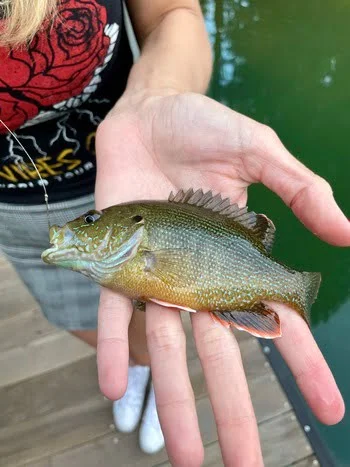
What do Green Sunfish Eat?
Green sunfish eat very similar to bluegills and other sunfish.
Green sunfish are omnivores which means they consume both plant and animal matter. They eat insects, larvae, zooplankton, eggs, snails, crawfish, eggs, fry, and other small forage fish.
In aquariums or residential ponds, they are also known to eat commercial fish food, bread, and corn.
Are Green Sunfish Aggressive?
Green Sunfish are not aggressive toward humans and do not have sharp teeth.
However, they are known to be aggressive toward other sunfish species, especially in small ponds or aquariums.
They are a competitive species and have aggressive feeding patterns.
Do Green Sunfish have Teeth?
Like many species of sunfish in the Centrarchidae family, they have rows of palatine teeth on the roof of the mouth. These do not pose a threat to humans.
What is the Difference Between a Bluegill and a Green Sunfish?
The image below depicts some of the key differences between bluegill and green sunfish, including body and mouth shape and operculum color and placement.
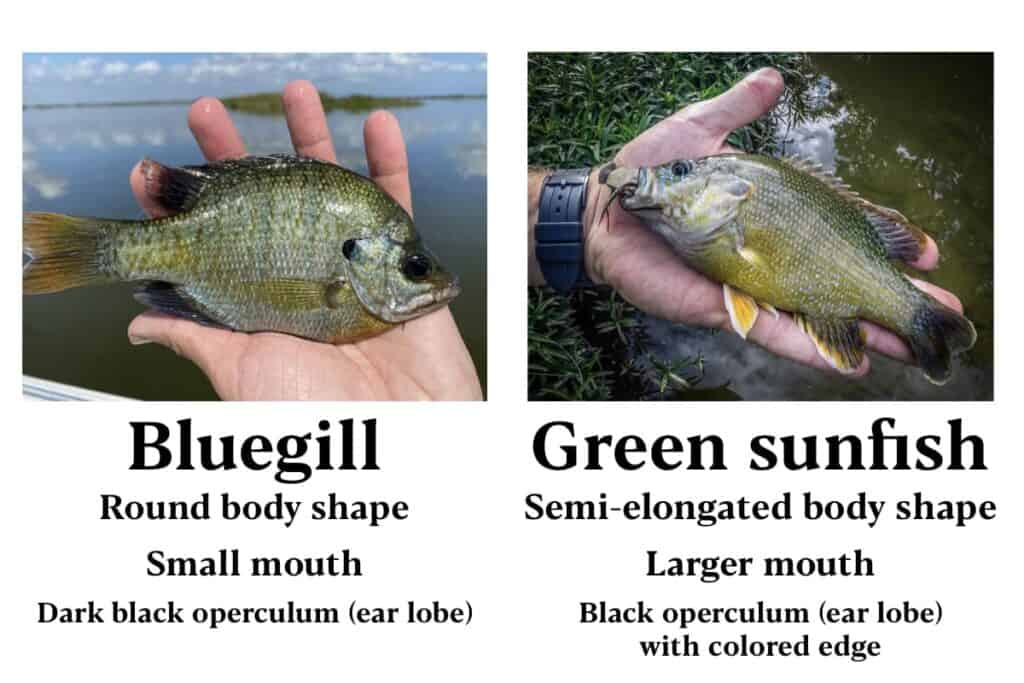
Bluegill are often confused with other species of sunfish, and technically they are a member of the sunfish family.
Will Bass Eat Green Sunfish?
Yes, Largemouth Bass will eat Green Sunfish. Many species of fish prey on Green Sunfish, including Northern Pike, Musky, and Flathead Catfish.
What is the World Record Green Sunfish?
The World Record Green Sunfish is 2 lbs 2oz (0.96kg) and was caught by Paul Dilley in Stockton Lake, Missouri USA on June 18th, 1971.
Conclusion
Green Sunfish are a very common species of panfish found throughout North America.
Many kids and young anglers get their first taste of fishing when catching Green Sunfish off their grandpa’s dock or at the local pond.
Although they don’t have the angling reputation of their cousin the Bluegill or Black Crappie, they pack quite the punch in a small package.
They are easily caught on a variety of live baits such as insects and worms, or on artificial lures like small tube jigs and flies.
You May Also Like: Lures for Bluegill- The Top 10 Best of All Time.
If you haven’t guessed yet, I love fishing and everything about it!
To learn more about why I started Panfish Nation, visit the About page and follow along on Social Media:


Download a copy of my FREE Lure Color Selection Chart & Knot Guide!
Stay up to date with fishing reports, tackle reviews, industry news, and much more! We respect your privacy, unsubscribe at any time.
